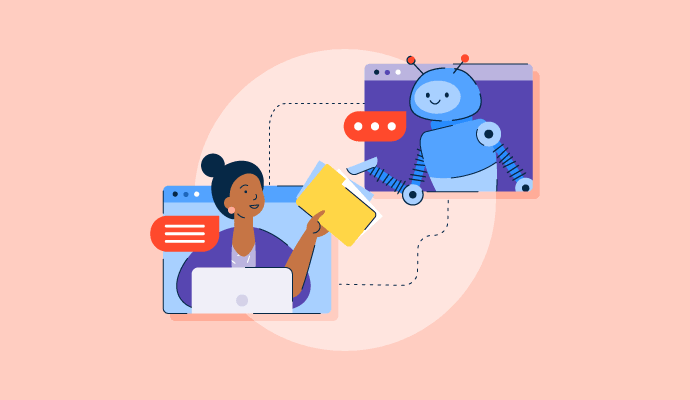What is a chatbot?
Chatbots, short for chatterbots, are automated customer service tools used in place of humans to provide information, respond to requests, and delegate tasks. They simulate a written or spoken interaction between two human users. People sometimes refer to chatbots as talk bots, virtual assistants, or interactive agents.
The best chatbot software automates tasks and conversations that replace human intervention. It’s used for 24/7 online support, quick FAQ responses, customer feedback collection, and order assistance. Companies are even starting to add recruitment chatbots to their hiring practices.
Types of chatbots
Organizations worldwide use chatbots to enhance the customer service experience. Some of the most common types of chatbots include:
- Menu-based (button) chatbots: These follow a decision tree hierarchy and present consumers with options for assistance via clickable buttons. Users select the options that best match their needs to reach a solution addressing their issue. Menu-based chatbots are suitable for answering frequently asked questions and common support requests, as little complexity and customization are involved.
- Rule-based chatbots: Businesses that can predict what their customers will ask use if/then logic to answer questions. Rule-based chatbots can only answer questions using a predefined set of rules and a script to accompany the rules. This type of chatbot takes time to develop as it may be a heavy lift to define conditions, assess potential customer input, and create response outputs.
- Keyword recognition-based chatbots: More advanced than menu-based chatbots, these chatbots identify relevant keywords in customer queries and provide answers based on the keywords. They use Natural Language Processing (NLP) to determine appropriate responses. They’re great for spitting out answers quickly. However, they are problematic when keyword similarities or redundancies make it challenging to determine a relevant answer.
- Voice bots: This type of chatbot communicates through vocal input and output. Users speak to the chatbot, and it responds using NLP and other speech recognition technology to craft a response. Voice bots work well for rapidly growing organizations that need more resources to address support requests; however, they require a lot of effort to set up.
Benefits of chatbots
Businesses that use chatbots experience benefits across various areas. Some of these areas include financials, customer satisfaction, and workflow efficiencies, as well as some key advantages discussed below.
- Improve lead generation. Depending on how chatbots are set up, they can collect lead information for sales and marketing teams. Chatbots can ask users for more information before starting a session and inquire about the customer journey to understand where they are in the sales process.
- Enhance the customer service process. Chatbots optimize the customer service process while cutting back on the resources needed. In addition, companies can scale their chat support and enable customer service models like 24/7 availability. Chatbots offer answers quickly with little-to-no wait time. Instead of calling and speaking to someone on the phone, customers can get responses to their questions with minimal effort and time.
- Provide omnichannel support. Businesses can use chatbots on messaging and social network platforms to boost their presence and provide support wherever their customers are. Layers of support lead to more customer happiness since their experience is more convenient.
Chatbots best practices
When implementing a chatbot for the first time, businesses should keep the following best practices in mind to ensure the highest likelihood of success.
- Choose the right type of chatbot. Ultimately, a chatbot solves business problems, whether providing customer support, improving the sales process, or acquiring new customers. Businesses should consider what they want to use a chatbot for and what issues it will solve to determine which type is the best fit for their needs.
- Don’t skip the planning process. Establishing chatbot KPIs and mapping various scenarios before implementing the tool is essential to creating successful outcomes. Teams should conduct goal-planning sessions and script potential customer-chatbot interactions to paint a complete picture view.
- Design a chatbot with personality. All business interactions, including those with chatbots, contribute to a customer’s experience and interpretation of the brand image. A chatbot should be designed with the brand image in mind to better appeal to the target audience.
- Prioritize the navigation experience. For the best possible customer experience, the chatbot navigation must be easy to use and understand. Customers lose interest and become frustrated if it’s challenging to navigate the conversation or if they have to start over if they select the wrong option.
Chatbots vs. live chat
Businesses use chatbots and live chat to provide a high-quality customer experience and easy access to support. The tools differ slightly, and they can be used together or separately.
Chatbots are automated conversational interfaces that mimic human conversations. They engage with customers, respond to basic questions and queries, and provide support 24/7.
Live chat is a communication channel that helps businesses message back and forth with customers in real time. Businesses can offer 24/7 live chat support; however, this option requires that humans work shifts around the clock to respond to customers.
Learn how different types of artificial intelligence, including chatbots, can boost business operations and workflows.

Alyssa Towns
Alyssa Towns works in communications and change management and is a freelance writer for G2. She mainly writes SaaS, productivity, and career-adjacent content. In her spare time, Alyssa is either enjoying a new restaurant with her husband, playing with her Bengal cats Yeti and Yowie, adventuring outdoors, or reading a book from her TBR list.




















